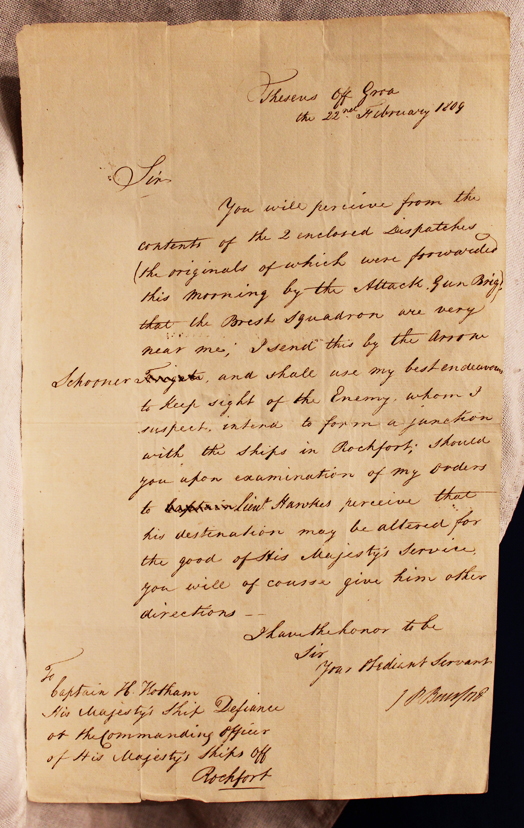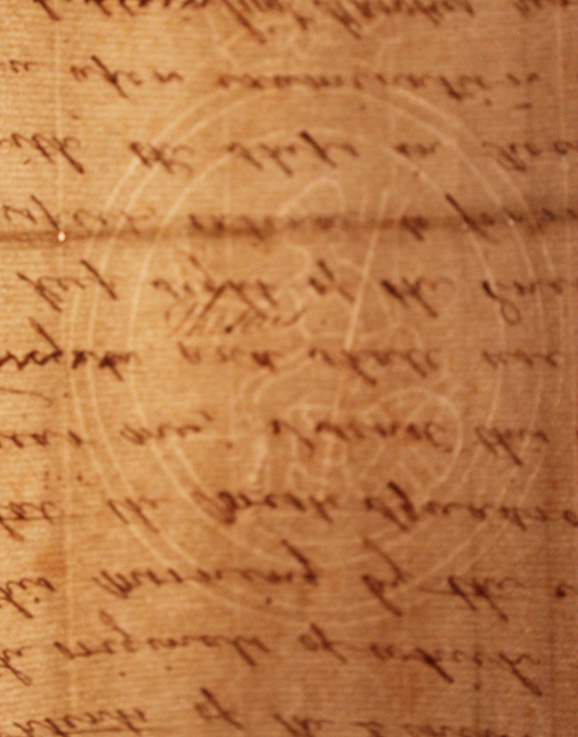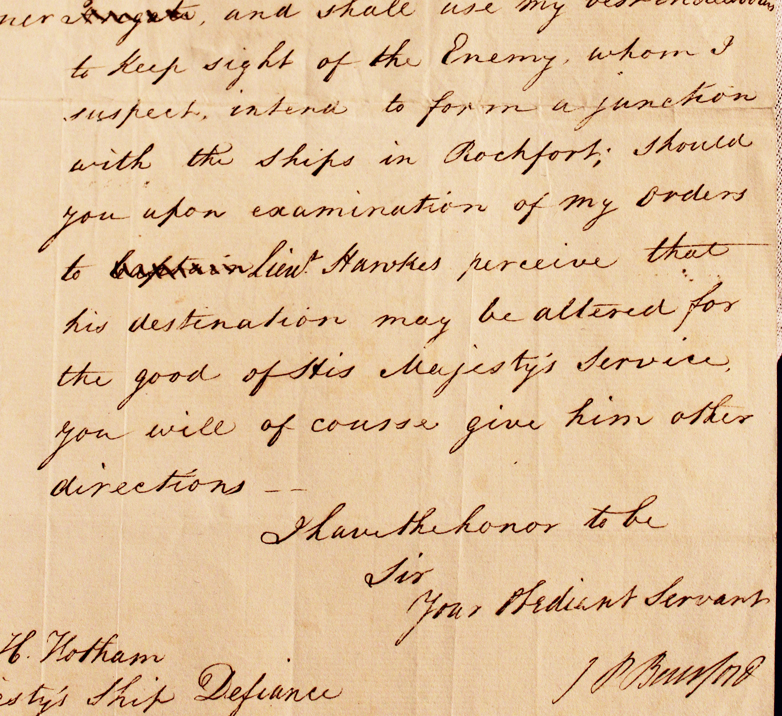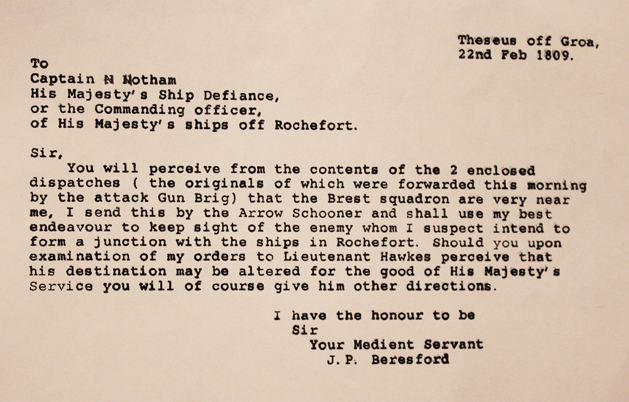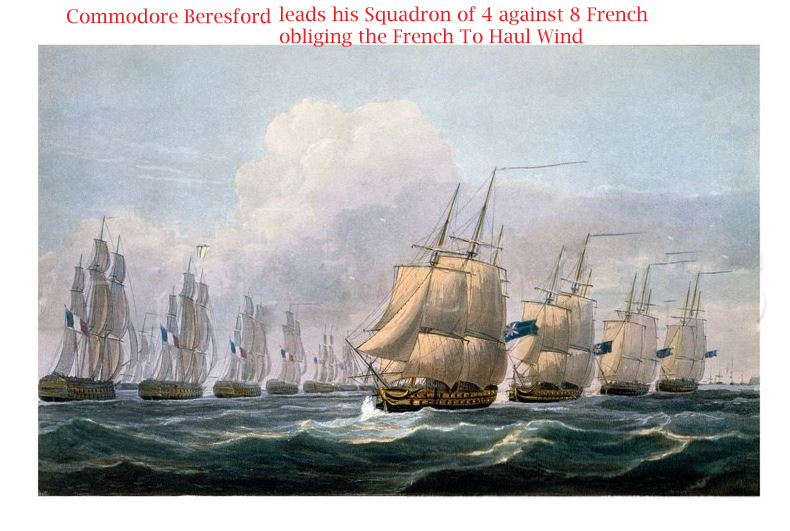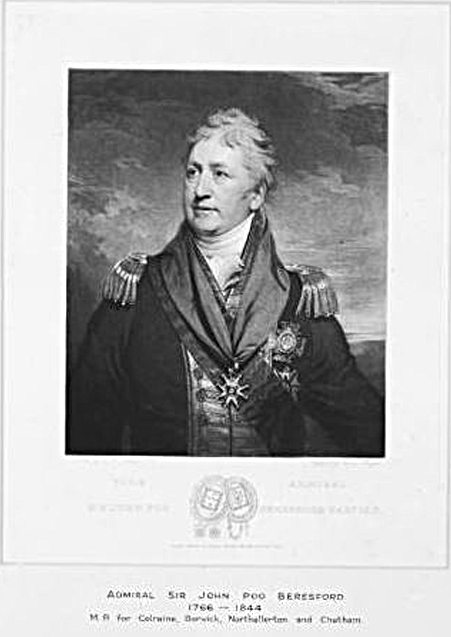A Despatch From Commodore James Poo Beresford HMS Theseus 2 Feb 1809
Shortly before the Battle of the Basque Roads. Written and signed by Commodore [Later Admiral] Beresford aboard and in command of HMS Theseus. Some few years earlier Theseus was the flagship of Rear Admiral Horatio Nelson's fleet for the 1797 Battle of Santa Cruz de Tenerife. Day to day command at that time was vested in her flag captain Ralph Willett Miller. Unfortunately on this occasion the navy was defeated and Nelson was wounded by a musket ball while aboard the Theseus, precipitating the amputation of his right arm. In 1798, Theseus took part in the decisive and hugely successful Battle of the Nile, under the command of Captain Ralph Willett Miller. The Royal Navy fleet was outnumbered, at least in firepower, by the French fleet, which boasted the 118-gun ship-of-the-line L'Orient, three 80-gun warships and nine of the popular 74-gun ships. The Royal Navy fleet in comparison had just thirteen 74-gun ships and one 50-gun fourth-rate.
During the battle Theseus, along with Goliath, assisted Alexander and Majestic, who were being attacked by a number of French warships. The French frigate Artemise surrendered to the British, with the crew setting fire to their ship to prevent it falling into the hands of the British. Two other French ships Heureux and Mercure ran aground and soon surrendered after a brief encounter with three British warships, one of which was Theseus. L'Orient was destroyed in the battle by what was said to be the greatest man made explosion ever to have been witnessed. It was heard and felt over 15 miles distant.
The battle was a success for the Royal Navy, as well as for the career of Admiral Nelson. It cut supply lines to the French army in Egypt, whose wider objective was to threaten British India. The casualties were heavy; the French suffered over 1,700 killed, over 600 wounded and 3,000 captured. The British suffered 218 dead and 677 wounded. Nine French warships were captured and two destroyed. Two other French warships managed to escape. Theseus had five sailors killed and thirty wounded, included one officer and five Royal Marines. A painting in the gallery of Commodore Beresford leading his squadron of ships from 'The Naval Chronology of Great Britain', by J. Ralfe, leading a British squadron of 4 sail of the line near the Isle of Grouais in the face of the French Brest fleet of 8 of the line obliging the French to haul their wind and preventing them from joining the L'Orient squadron. The three ships alongside Beresford were HMS Revenge, Valiant and Triumph, and the Triumph was commanded by none other than Capt. Sir Thomas Masterman Hardy. Beresford was a natural son of Lord de la Poer the Marquess of Waterford. He joined the Royal Navy and he served in HMS Alexander in 1782. He was appointed as a Lieutenant RN serving on H.M.S. Lapwing 1790. He served in H.M.S. Resolution 1794. He served in H.M.S. Lynx (In command) in 1794. He was appointed as Acting Captain RN in 1794 serving in H.M.S. Hussar (In command). He was appointed as a Captain RN (With seniority dated 25/06/1795). He served in H.M.S. Raison (In command) 1795. He served in H.M.S. Unite (In command) 1798. He served in H.M.S. Diana (In command). He served in H.M.S. Virginie (In command) 1803. He served in H.M.S. Cambrian (In command) 1803. He was appointed as a Commodore RN 1806. He was appointed as the Commander-in-Chief in the River St. Lawrence, along the Coast of Nova Scotia, the islands of St. John and Cape Breton and in the Bay of Fundy and the Islands of Bermuda. He served in H.M.S. Theseus (In command) 1808. He served in H.M.S. Poitiers (In command) 1810. He served on to the staff of Lord Wellington at Lisbon Portugal 1810. During the War of 1812, he served as captain of HMS Poictiers, during which time he ineffectually bombarded the town of Lewes in Delaware. More importantly, Poictiers participated in an action where, four hours after USS Wasp, commanded by Jacob Jones, captured HMS Frolic, Capt Beresford captured Wasp and recaptured Frolic, and brought both to Bermuda. He was appointed as a Commodore RN in 1813. He served in HMS Royal Sovereign (In command) 1814. He was appointed as a Rear Admiral of the Blue (With seniority dated 04/06/1814). He was appointed as Commander-in-Chief at Leith 1820-23. He was appointed as the Commander-in-Chief at The Nore 1830-33. He was appointed as a Vice Admiral RN (With seniority dated 27/05/1825). He was appointed as a Junior Lord of the Admiralty in 1835. He was finally appointed as a Admiral RN (With seniority dated 28/06/1838). The typed transcript shown in the gallery states 'mediant servant' of course it should be 'obedient servant'
Code: 19654
1975.00 GBP

